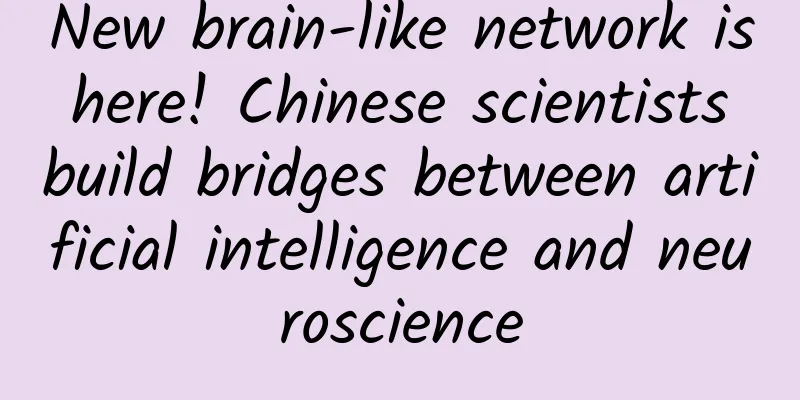New brain-like network is here! Chinese scientists build bridges between artificial intelligence and neuroscience

|
Author: Huang Yanhong, Huang Xianghong, Duan Yuechu In the 21st century, when science and technology are changing with each passing day, the development of artificial intelligence is like a surging wave, constantly impacting our cognition and life. On August 19, 2024, an exciting news came: Chinese scientists successfully built a new brain-like network, building a solid bridge between artificial intelligence and neuroscience. This breakthrough not only caused a huge sensation in the scientific community, but also opened a new chapter for human beings to explore the mysteries of intelligence. Let's go back to August 16, when the team of researchers Li Guoqi and Xu Bo from the Institute of Automation of the Chinese Academy of Sciences, together with research forces from Tsinghua University and Peking University, jointly proposed a method for building a brain-like neuron model "based on endogenous complexity". This method is like a ray of light, illuminating the fog that artificial intelligence faces on its development path. Currently, the field of artificial intelligence is striving towards the important goal of building a more general intelligent model. In the process of pursuing this goal, the current popular large model path is mainly based on the law of scaling, building larger, deeper and wider neural networks, that is, the general intelligence implementation method "based on exogenous complexity". However, this method is not smooth sailing, and it faces many severe challenges. This path consumes a lot of computing resources and energy. As the model size continues to expand, the computing cost grows exponentially, and the demand for resources has reached an unsustainable level. Imagine that in order to train a super-large neural network model, a huge data center is needed, consuming a lot of electricity, which not only puts a huge pressure on the environment, but also makes its application cost high. Lack of interpretability is another problem that plagues researchers. These large and complex neural network models are like a black box. Although they can give accurate prediction results, it is difficult for us to understand their internal decision-making process and logic. This means that when we use these models, we can only blindly trust their outputs without truly understanding the principles and mechanisms behind them. When we turn our attention to the human brain, we can find an amazing miracle. The human brain has about 100 billion neurons and about 100 trillion synaptic connections. Such a complex structure can run efficiently with only about 20 watts of power consumption. This makes scientists think: Can we learn from the dynamic characteristics of brain neurons, enrich the neuronal structure from the inside, and explore the potential of general intelligence? The answer is yes, this is the method of realizing general intelligence "based on endogenous complexity". So how does the "intrinsic complexity-based" brain-like neuron model work? Simply put, it attempts to simulate the rich and diverse structures and dynamic characteristics of brain neurons. Traditional neuron models are often oversimplified and ignore many key details. The new model is closer to real neuron behavior and can better handle complex information and tasks. Researcher Li Guoqi pointed out that the experimental results have fully verified the excellent performance of the endogenous complexity model in dealing with complex tasks. It has not only significantly improved accuracy, but also has obvious advantages in computing efficiency and energy consumption. This means that we no longer need to rely on continuously increasing the size of the model to improve performance, but can achieve more efficient and intelligent computing by deeply exploring the complexity inside neurons. This research result provides a new method and solid theoretical support for integrating the complex dynamic characteristics of neuroscience into artificial intelligence. It allows us to see a new direction for the development of artificial intelligence, no longer simply pursuing scale and speed, but focusing more on simulating the internal mechanisms of the brain to achieve more intelligent, efficient and sustainable development. What kind of changes will this achievement bring in practical applications? First, in the medical field, artificial intelligence is expected to provide more accurate and personalized solutions for the diagnosis and treatment of diseases. By simulating the brain's cognitive and decision-making processes, artificial intelligence systems can more accurately analyze medical images and interpret biological data, thereby helping doctors detect diseases earlier and develop more effective treatment plans. In the field of education, artificial intelligence models based on endogenous complexity can provide students with a more personalized learning experience. It can adaptively adjust teaching content and methods according to each student's learning characteristics and progress, thereby improving learning effectiveness and efficiency. In the field of transportation, intelligent transportation systems can more accurately predict traffic flow and optimize traffic signal control, thereby alleviating traffic congestion and improving travel efficiency and safety. In the financial field, risk assessment and investment decisions can become more precise and intelligent, reducing financial risks and improving market stability and efficiency. Of course, this achievement is just a new starting point, and the research team has been working non-stop to carry out further research. They hope to further improve the computing efficiency and task processing capabilities of large models and realize their rapid implementation in more practical application scenarios. This requires not only continuous innovation and breakthroughs in technology by scientists, but also support and cooperation from all walks of life. In the days ahead, we have reason to believe that as the research on brain-like networks based on endogenous complexity continues to deepen and improve, artificial intelligence will truly be integrated into all aspects of our lives, bringing unprecedented convenience and well-being to mankind. It will no longer be an unattainable science fiction dream, but a powerful force that can actually change our lives. Let us look forward to this exciting technological revolution, be proud of the outstanding achievements of our country's scientists, and be full of confidence in the future of human intelligence! The cover image is a copyrighted image of the gallery. Reprinting and using it may cause copyright disputes. |
<<: "Sleeping on a hard bed is good for your waist"? You will understand after reading this
>>: A photon’s autobiography: What’s so magical about the quantum world?
Recommend
Operational Promotion: What is the promotional strategy behind Alipay’s “face payment”?
To be honest, I was tricked by Alipay a few days ...
Do you feel sleepy when it rains? Huaxi doctors say it may be because your brain is "hypnotized" by you
The rain in Chengdu is really capricious It's...
Is it appropriate for residents of the community to put disinfectant tablets into the sewers at the same time?
Recently, a piece of news spread on the Internet....
"Chasing the Light" Kola - Visiting the Construction Site of the World's Largest Water-Photovoltaic Complementary Project
——Visiting the construction site of the world'...
Shanxi prohibits fireworks and firecrackers at weddings and funerals (with original text)
Shanxi bans fireworks at weddings and funerals To...
Is it okay to skip the digital anal exam if you think it's too embarrassing or uncomfortable? Don't, because...
"Digital rectal examination is uncomfortable...
Free money Lujiang March 2022 courses
Free Money Lujiang March 2022 course resources in...
Was the disappeared ice field "giant horned monster" already picked up by a prehistoric cave "artist"?
In December 1994, French explorer Jean-Marin Chau...
The "First Yangtze River Bridge" spans the north and south, turning the natural barrier into a thoroughfare
In 1957, many parents in Wuhan tried every possib...
Baidu announces pure vision L4 autonomous driving solution "Apollo Lite"
At CVPR (the world's top academic conference ...
The logic behind traffic: How to achieve community fission growth?
This article uses real data to deeply reveal the ...
Places to drink tea in Yuelu District, Changsha High-end studio takeaway recommended for tea tasting
Places for drinking tea in Yuelu District, Changs...
In addition to the small market, the people are really not good enough. Why are Chinese electric vehicles flocking to Mexico?
What role do small and medium-sized countries pla...
Why is the high-speed rail so fast? What is the source of its power?
As a convenient means of transportation in today&...









